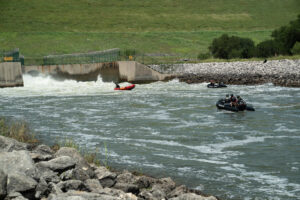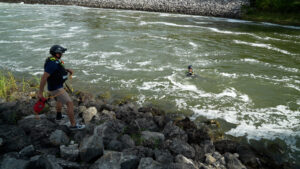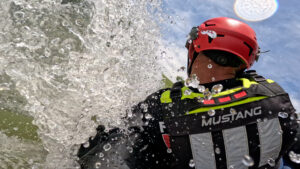
By Eric Franklin
Fort Hood Public Affairs
BELTON, Texas — Firefighters from Fort Hood and the Killeen Fire Department spent July 21-23 training in swift water rescue techniques below Belton Lake Dam, taking advantage of rare moving water conditions to strengthen life-saving skills.
The Fort Hood Fire Department led the joint training effort, using the dam’s controlled-water release to simulate realistic flood rescues in fast-moving current. This valuable opportunity comes only a few times a year, if then.
“This is the live action, like you said, with the moving water,” said James Wallace, battalion chief for the Fort Hood Fire Department. “It presents the different dangers, the characteristics of moving water that we’re going to put firefighters in, so they’re exposed, and they’re able to read the water and understand the environment that they’re going to be in before we actually put them in an emergency situation.”
Over 50 personnel from both departments participated in the drills, which included survival swimming, rope rescues, raft flips and boat operations. The goal was to build confidence and readiness before firefighters are called to real flood events.
“Repetitions kind of build the muscle memory that we need to execute,” Wallace said. “Because in a situation like that, we don’t really have the time to react — you’re just reacting based off of your training.”
Killeen Fire Department Captain Marcus Stillwell, whose team trains both locally and statewide through Texas Task Force 1, emphasized the importance of regularly practicing these rescue skills.
“The training is vital,” Stillwell said. “A lot of the skills that we do, they’re very perishable. So, if we don’t do them on a continuous basis, you kind of lose those skills. And the more you train, the safer it is.”
He also spoke to the strong working relationship between Fort Hood and Killeen when major flood events occur.
“We work hand in hand in the area for mutual aid,” Stillwell said. “If we get a call and we don’t have the resources to staff two boat teams for that specific incident, we’ll call them for mutual aid, and they’ll back us up. We’ll back them up if they get a bunch of flooding on the installation. We’ll go help them out and vice versa.”
Among the participants was Pvt. Hunter Lykins, a new Army firefighter assigned to Forward Support Company,62nd Engineer Battalion,36th Engineer Brigade, attending his first field training since completing fire academy at Goodfellow Air Force Base.
“I mean, it’s fun. Without a doubt, it’s definitely fun,” Lykins said. “And it’s the real thing that sets me up for civilian life if I decide to get out. So, you know, nothing but blessed to be here. Knowing that there’s so few of us, I definitely got lucky getting in.”
For Lykins, the team dynamic stood out just as much as the technical training.
“I know they’re going to have my back if anything is going on,” he said. “Regardless of who’s there, who’s on a shift — as long as we’re going somewhere, we’re all same team, same mind. It’s not necessarily a safe space, you know, dangerous job, but you got plenty of good people to back you up.”
Wallace said real-world rescues — including recent flood operations in Lampasas — have already put these exact training methods to use.
“All the skills that are out here today have been executed in the Central Texas area and have resulted in a direct saving of lives,” he said. “So, nothing that you see today is not anything that hasn’t been applied in an emergency situation and truly works, has been vetted and has been proven to be effective.”











